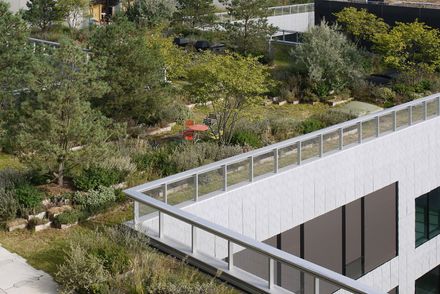Toni Areal Roof Garden
ARCHITECTS
Studio Vulkan Landscape Architecture
CLIENT
Allreal Generalunternehmung AG
MANUFACTURERS
WALO Bertschinger, Forster Baugrün, STA Struktuwerkstoffe Altenrhein, Tschümperlin
LEAD ARCHITECTS
EM2N Architects, Zurich; Studio Vulkan Landscape Architecture, Zurich
PHOTOGRAPHS
Roland Bernath, Filip Dujardin, Noemi Chow, Daniela Valentini, Roland Tännler
ENGINEERING
Walt + Galmarini AG
AREA
2600 m²
YEAR
2014
LOCATION
Zürich, Switzerland
CATAGORY
Landscape Architecture
Text description provided by architect.
Density, urbanity and exciting intensity – 30 metres above ground in Zurich West. On the roof garden of the new University of the Arts on the site of the former Toni factory, the outdoor space creates a green oasis for students in an area where there has been a surge of new high-rises, technical buildings, chimneys, atriums and concert halls.
Here, plants grow in wooden boxes stacked to create a pixel-like rugged landscape. It is a paradoxical garden: built in no time and ready for use on the final day of construction, it hasn’t, unlike most parks, gone through a long development phase.
Yet the lush garden is far from finished – its primary principle is not growth, but decay. A 2,600 m2 urban world with the appearance and radical individuality of a small private garden.
The stacked boxes were pre-cultivated over two years with a colourful mix of plants suitable for the environment, including perennials, herbs and small shrubs such as willow.
Eventually, the boxes will decay, the plant species will mix and the pixelated landscape will grow into soft mounds, forming the roof’s base soil layer that will enable plant growth.
This specific system and strong identity is the result of a careful study of the location and the envisaged intense level of use from the beginning, combined with the availability of water on the roof, short construction period and architectural limits on structural height.
As a symbiosis of nature and artificiality, the rugged world of stacked pixels reflects the place and the environment.
Here, the much-cited processuality of landscape architecture has been reversed: the process begins at the apparent end – with decay.




















